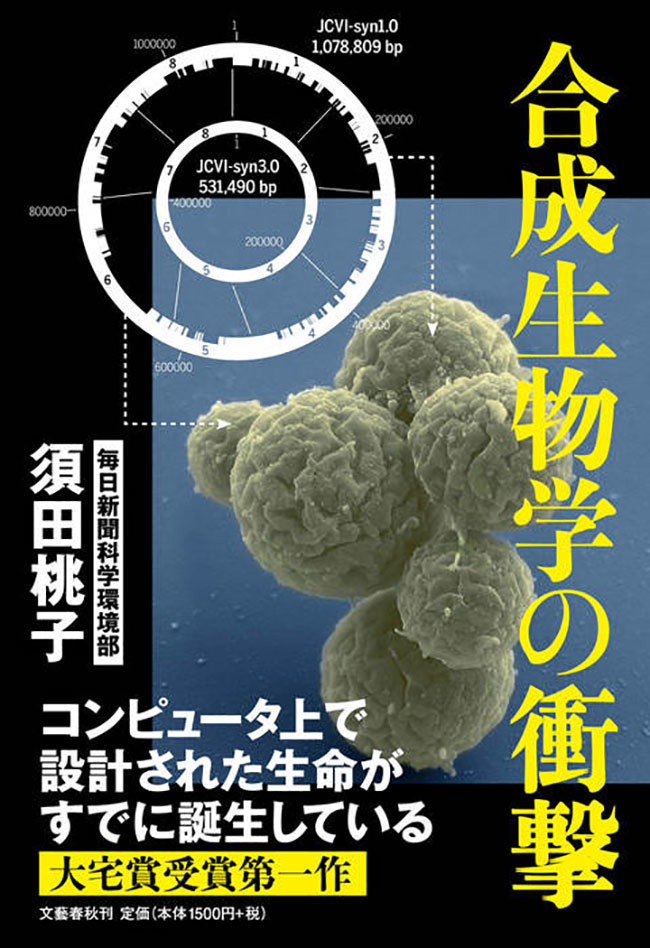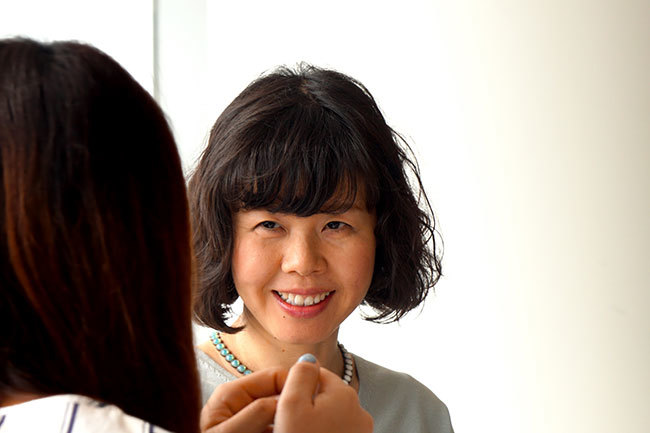Note: This website was automatically translated, so some terms or nuances may not be completely accurate.
Interview with Momoko Suda: America Creating Industrial Waves with Genomics, and Japan Riding the Wave Ahead

Momoko Suda
Mainichi Newspapers Co., Ltd.

Misato Mikami
Dentsu Inc.

Smartcell & Design is a cross-organizational team tackling business design utilizing "Smartcell," a highly functional genome. Following the first installment introducing the social context surrounding genome editing and synthesis and this project's activities, the second installment features an interview with Momoko Suda, a reporter from the Mainichi Shimbun's Science and Environment Department who continues to cover genome editing and synthesis domestically and internationally. Alongside content from her book The Impact of Synthetic Biology, released on April 13, Smartcell & Design member Misato Mikami of Dentsu Inc. asked about the current state of the US, leading the way in industrialization, and the future for Japan.

It's about "synthesis," not just "decoding"
Mikami: As DNA analysis tools become more widespread and gain attention, we're talking with Ms. Suda—who focuses on "genome synthesis," a cutting-edge technology that goes beyond "decoding" and "genome editing" (specifically rewriting designated sections) to build new genomes from scratch—about the potential and future possibilities of genome synthesis.
What sparked your interest in genome synthesis and synthetic biology in a broader sense, leading you to begin covering it?
Suda: Having covered life sciences for a long time, I've always been interested in the future of biology. However, my particular fascination with synthetic biology began in March 2016 when Craig Venter announced the successful creation of a minimal cell (※1).
Through subsequent interviews with researchers in Japan, I came to understand that genome sequencing means converting the genome into digital information, enabling the manipulation of the genome sequence—often called the "blueprint of life"—on a computer. Furthermore, I grasped that Venter's work involved taking this digitally rewritten blueprint and actually inserting it into living cells to make it function. This sparked an intense interest and sense of potential in me.
Later, during his lecture in Japan, separate from the minimal cell discussion, he introduced a business at his medical application company. This business uses big data linking customers' genomes with their physical characteristics and medical histories to predict diseases each individual is susceptible to based on their genome.
I was astonished not only by his synthetic biology research but also by the fact that he was already developing genomic medicine as a business. I wanted to see the American synthetic biology community that produced such a dynamic thinker, so I traveled to the US to study and conduct interviews.

Mikami: What were your first impressions upon arriving in the U.S.?
Suda: Before going, I was aware of the commercialization of genome sequencing, but the industrialization of synthetic biology technologies wasn't really visible in Japan. Everyone I met there unanimously said, "It's really happening," and books published in the US during my stay also emphasized this, making me strongly realize for the first time that industrialization was a reality.
*1 Minimal Cell
A Mycoplasma cell with the smallest genome ever created artificially from scratch, not edited, published in Science magazine by Dr. Craig Venter in March 2016.
The Wave of Genome Industrialization Seen in the US
Mikami: Even in Japan, information exists about the global smart cell industry market growing to ¥80 trillion by 2030, but it remains somewhat vague. What businesses left a strong impression on you?
Suda: Two stand out. Starting with the more concrete example, Amyris. When discussing the industrialization of synthetic biology technology, this company is often the first name mentioned. It began with technology to produce the raw material for a malaria drug—originally extractable only from plants—using genetically modified yeast. Today, that technology has been adapted not only for pharmaceuticals but also for ingredients in cosmetics and perfumes.
Mikami: Bio-beauty serums (basic cosmetics containing materials made with biotechnology) are also sold in Japan, right?
Suda: Those ingredients are produced at their factory in Brazil. I was surprised to see Japanese companies listed among the product showcases. At their headquarters lab in California, everything was automated—from yeast genetic modification to selecting yeast strains capable of mass production. The synthetic biology company Ginkgo Bioworks in Boston had a very similar lab.

Suda: Another thing was that one of the themes at the iGEM Giant Jamboree I attended was "Current State of Industrialization." At the kickoff meeting for the Genome Synthesis Project held in New York in May 2017, startups also saw it as a business opportunity, and as media, I received a private briefing from one company. Several Japanese companies were there too, but they seemed mainly to be observing.
Regarding genome synthesis technology, many companies have already commercialized shorter DNA lengths. The focus now seems to be shifting toward achieving longer and more accurate synthesis.
Mikami: I had imagined R&D progressed purely out of curiosity, so it's surprising to learn business opportunities are also factored in.
Suda: Before going to the U.S., I thought the genome project was "a project by academia, for academia." But after actually going, I got a different impression. For example, Autodesk, known for CAD development, was involved in proposing the Human Genome Synthesis Project. Perhaps they're trying to create CAD software for life's blueprint. There's also active investment to stimulate the market. But when we say "market," it's incredibly diverse, spanning bioenergy, cosmetics, pharmaceuticals, biology, the environment, and many other fields.
Mikami: Food is included too, right?
Suda: Yes. There are projects focused on creating food that is lower cost, lower energy, and less burdensome on the environment.
Mikami: Precisely because of this diversity and sense of potential, we need to consider which field is most suitable for Japan to enter.
※2 iGEM
An annual synthetic biology competition organized by MIT for students, akin to a hackathon. Teams design and synthesize standardized genetic parts, with their ideas and technical skills evaluated. The team from Tokyo Institute of Technology in Japan has won the gold medal every year since its inception 11 years ago.
The official name is The International Genetically Engineered Machine competition.
※3 Human Genome Project-write
A plan to artificially synthesize the human genome, whose concept was announced in Science magazine in February 2016. Conceived as the Human Genome Project-write, it aimed not only to improve technology but also to raise societal interest in synthetic biology. After debate, it was renamed the Genome Project-write and launched in 2017.
Responsible Science for Japan to Ride the Industrialization Wave
Mikami: The human genome discussion involves significant ethical issues, doesn't it? In your recent book, The Impact of Synthetic Biology, you also provide detailed summaries of specific research and technological examples. Is that because understanding the technology can alleviate fear of the unknown and enable sound judgment?

Suda: Yes. I believe substantive discussions cannot begin without a certain level of shared information about the content and current state of science and technology. That's why I place great importance on communicating accurately and clearly.
Related to this, I frequently heard terms like "Responsible Innovation" and "Responsible Science" in the United States.
Essentially, it means that explaining technology only at the stage of development and market release is too late. It's crucial to start considering ethical and regulatory issues from the initial idea stage and begin dialogue and discussion with society. Within the academic scientific community, there's a sense that the introduction of genetically modified crops was a failure in this regard, and it seems to serve as a lesson.
Synthetic biology technologies, when applied correctly, can bring significant benefits to society. However, because they create organisms that do not exist in nature, they inherently carry ethical concerns. Potential risks include unexpected negative impacts on ecosystems and the possibility of misuse in warfare or terrorism. For example, when the Human Genome Synthesis Project was first proposed, concerns were raised: "Who will stop the military from creating parentless soldiers in the future?"
Given these risks, it's certainly possible society might decide to reject the technology. For society to reap the benefits, scientists must actively participate in the discussion. It will be crucial for Japan going forward that they disclose not only the technical details but also the utility and risks, deepening dialogue with society.
Mikami: I see. So, for Japanese society to make the right judgment and establish this as an industry, dialogue at the technical level is indispensable.
We also believe that even if each of us won't use genome editing or synthetic biology technologies personally, we still need to understand them, which is why we've launched a project for children. When we held the "Touch the SmartCell!" event in the summer of 2017, the children who participated grasped genome technology much faster than we imagined. Especially when we talked about DNA storage, which records information in DNA, they immediately shared ideas like, "So can we embed games into our hands?" We felt the future possibilities opening up through their understanding of the technology.
Synthetic biology: Feeling vast potential and a near future
Suda: In the energy sector, ExxonMobil has already invested in Craig Venter's company and is engaged in R&D to produce biofuels from algae. According to Venter, while there are no technical issues, petroleum fuels currently remain more cost-effective. If the cost barrier can be overcome in the future, biofuels might be chosen when petroleum fuels become depleted or trigger conflicts.
Mikami: It could potentially eliminate one source of conflict, beyond just business and industrialization.

Suda: Watching American TV, I was struck by how frequently biofuel commercials aired. Light shines into a large green tube containing algae, and a female scientist states, "Someday, I'll be called an energy farmer." I ended up memorizing the content.
Mikami: Interesting. In the near future, communication around genome products might become commonplace in Japan too.
This ties into the discussion of responsible science. Of course, not everyone is interested in disclosed technologies, so we at Dentsu Inc. hope to play a role in the communications field, making it engaging for many people, just like this example. Dentsu Inc. already has experience in communications using genome sequencing technology, and we aim to expand into editing and synthesis going forward.
The Impact of Synthetic Biology
Mikami: Finally, in your book The Impact of Synthetic Biology, what was the most shocking thing for you, Mr. Suda?
Suda: Honestly, the biggest shock was the amount of investment from DARPA (※4). DARPA has focused on synthetic biology research since its dawn, investing in leading researchers and companies, and the scale of that investment grows year by year. While the U.S., unlike Japan, has a long-standing tradition of military-funded academic research, I was still shocked to find that many researchers explicitly recognize DARPA as their primary supporter, and nearly all interviewees had received DARPA funding.
While none of DARPA's synthetic biology R&D programs explicitly state offensive purposes, some researchers point out that even defense-oriented research, such as vaccine development, could potentially be repurposed for attack. Fundamentally, DARPA's primary purpose is not civilian application, but to bridge the gap between cutting-edge scientific research and military utilization as quickly as possible.
This book also explores the dangers of advancing synthetic biology research using military research budgets, through interviews with researchers like those who worked on biological weapons development using synthetic biology concepts in the former Soviet Union.
Mikami: While I've always felt the technological impact, the sheer scale of investment, foresight, and the fact that military and educational research institutions are so closely intertwined socially are all truly shocking.
For Japan to avoid being left behind in the coming wave of industrialization, disseminating information that enables society to make sound judgments is essential. And for those of us working in the genome field, it's crucial to establish proper criteria for judgment and make decisions without being swayed by short-term gains. Thank you for today.
※4 DARPA
DARPA is the acronym for the Defense Advanced Research Projects Agency, a U.S. military research and development agency focused on national security. Many technologies, such as the internet, voice recognition, and GPS, were initially developed by DARPA as military prototypes before being adapted for civilian use. Its full name is the Defense Advanced Research Projects Agency.
Was this article helpful?
Newsletter registration is here
We select and publish important news every day
For inquiries about this article
Author

Momoko Suda
Mainichi Newspapers Co., Ltd.
Science and Environment Department
reporter
I am covering the cutting edge of synthetic biology both domestically and internationally. His publications include The Impact of Synthetic Biology, which depicts the cutting edge of synthetic biology—a field with vast application potential yet also raising real-world concerns mirroring those posed in Kazuo Ishiguro's novel Never Let Me Go—and The Fabricated Scientist (both published by Bungeishunju), which won the Oya Soichi Nonfiction Award and the Science Journalist Grand Prize.

Misato Mikami
Dentsu Inc.
Marketing Creative Center
Joined the company in 2015. Specializes in communication design with a focus on digital creative output. Recently involved in new business areas such as research and development of new digital communication tools and business platform development.

